- Home
- Leisure & Lifestyle
- Food & Drink
- Recipes
- 12 Middle Eastern recipes for a feast at home
Over the past few decades Middle Eastern food has rocketed in popularity – not just in the UK but all around the world. And it’s not difficult to see why: wholesome, aromatic, and incredibly diverse, Middle Eastern cuisine is packed with complex flavours, and each dish is deliciously unique. Rich flavours are beautifully offset with scatterings of fresh herbs and dollops of yoghurt, and from zingy salads to rustic stews and sticky cakes, there’s something for everyone.
So, if you’d like to learn more about Middle Eastern food, we’ve got you covered. Some of the recipes below, like falafel and hummus, you may already be familiar with, but others, like koshari and tahdig, might surprise and delight you. Here are 12 Middle Eastern recipes to get you inspired.
1. Falafel

Let’s start with one of the most popular and pervasive Middle Eastern snacks: falafel. If you think falafels are dry and dull, it’s probably because you’ve just had bad falafel!
When done right these plant-based patties are so tasty that it’s no wonder why their origin is such a hotly contested issue. Crispy-fried shells hide a creamy, fluffy centre of mashed chickpeas or broad beans (or both), plus garlic and herbs.
The beauty of falafels isn’t only that they’re easy to make, but it’s also that they’re incredibly versatile: eat them in a pitta, add them to a salad, or simply smother them in hummus and hot sauce. Though they’re fried, they’re a great source of protein, high in many micronutrients, and packed with fibre and complex carbs. If you’d like to make a healthier version, just bake them instead of frying.
To make falafels, check out this recipe by Downshiftology or watch the video below.
2. Fattet hummus
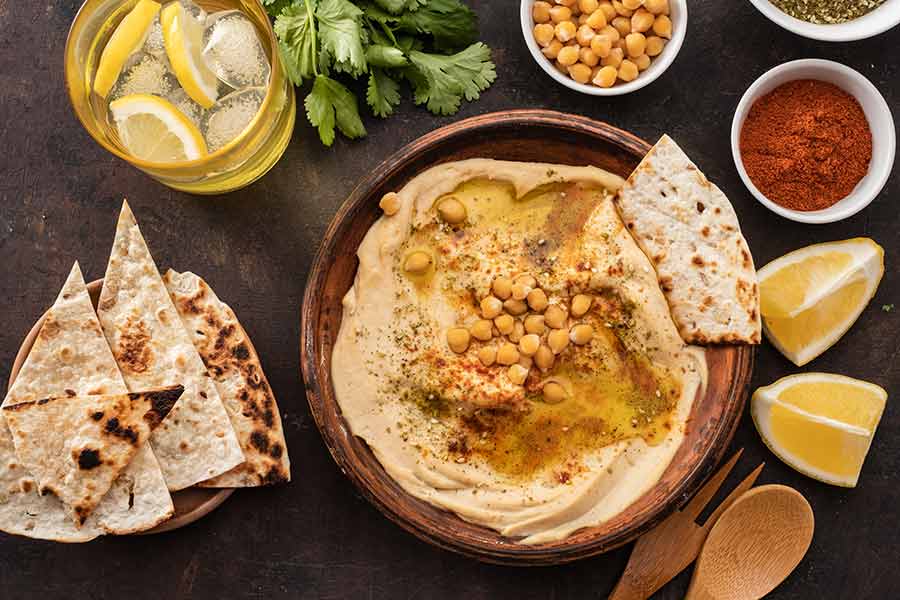
The perfect accompaniment to falafel is hummus; a dip that needs no introduction in the UK (almost half of us have a pot in the fridge!). But for something a bit more unusual, you might want to make fattet hummus.
A popular brunch in Palestine, Lebanon, and Syria, fattet hummus is basically a seriously amped up bowl of traditional hummus – and it’s absolutely delicious.
Crunchy slices of fried pitta bread are topped with layers of garlicky hummus, creamy yoghurt, crunchy pine nuts, juicy pomegranate seeds, and fresh parsley – and with so many flavours and textures, every mouthful is a delight. If you’ve made falafels, fattet hummus is perfect for dipping them in, but it’s equally enjoyable to eat straight out of the bowl.
To make fattet hummus, check out this recipe by Food52 or watch the video below.
3. Koshari

As the two recipes above show, chickpeas are a staple of Middle Eastern cooking, but while some chickpea-based dishes like falafel and hummus are well-known, others are a better-kept secret.
Koshari is Egypt’s national dish, and a popular street-food snack. It’s healthy, flavoursome, and uses ingredients you probably already have in the cupboard.
At first glance, koshari might sound a little unusual; it’s essentially a bowl of macaroni and chickpeas mixed with spiced lentils and rice, a spicy tomato sauce, and crispy fried onions. But if you make it once, there’s a very good chance you’ll make it again! Plus, it’s packed with protein and fibre, and will keep you full for hours.
To try making koshari, check out this recipe by the Mediterranean Dish or watch the video below.
4. Fattoush salad
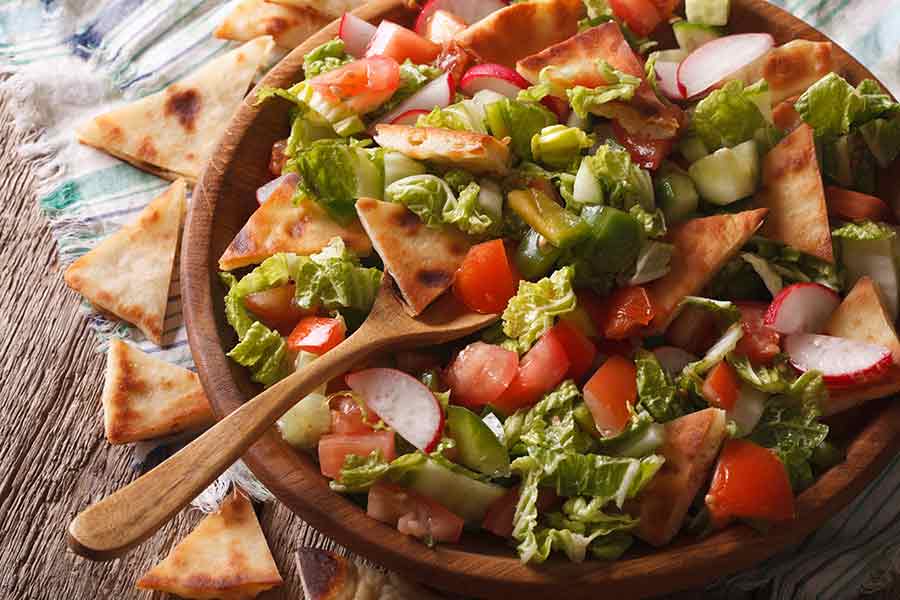
If you fancy something lighter and fresher, there’s fattoush, which is a fresh, bright Lebanese salad that’s eaten regularly throughout the Middle East.
If you love salad with croutons, like caesar salad, you’ll love fattoush, because this is another salad that adds a welcome crunch with chunks of crispy fried bread – only because this is Middle Eastern food, pitta bread is used.
There are no strict rules when it comes to which vegetables to use in fattoush. Typically it’s just veg that’s in season – though lettuce, tomatoes, cucumbers, radishes, spring onions, and parsley usually make an appearance. The dressing, made from olive oil, lemon juice, garlic, mint, sumac, and often pomegranate molasses, makes this zesty salad taste even more zingy and exotic.
To make your own fattoush, try this recipe from The Mediterranean Dish or watch the video below.
5. Manakeesh
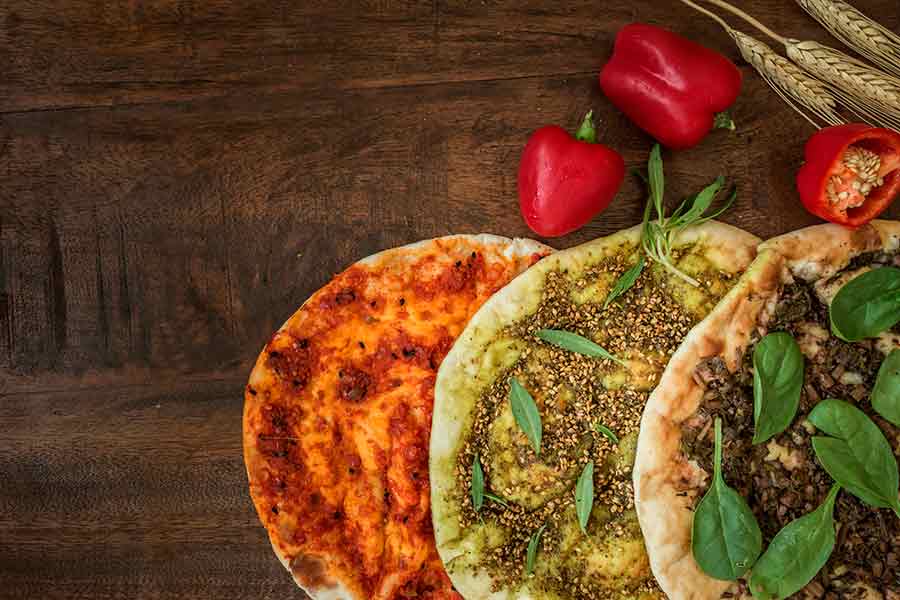
If you’re a fan of flatbreads and pizza-style dishes, then you have to try manakeesh.
Perfect for breakfast, brunch or lunch, these hearty bread snacks are eaten throughout Syria, Lebanon, Jordan, Palestine, and Israel, and are just as commonly found in fancy restaurants as on street-food stalls. Basically Middle Eastern pizza, the dough is rolled flat, and then topped with a variety of savoury fillings.
There are many variations of topping. The classic version is topped with olive oil and zaatar (a spice mix made with sumac, thyme, and sesame seeds that you can buy pre-blended or make yourself).
Other versions include a form of dairy – either labneh or feta cheese – or minced lamb. If you want to go all out, you could add all three! Add slices of tomato, onions and cucumber for extra crunch.
Try this recipe from Feel Good Foodie or have a watch of the video below.
6. Baklava

If you love sweet, sticky treats, there’s a good chance you’ll fall in love with baklava.
A popular dessert since the time of the Ottoman Empire, today baklava is a common dessert in Turkey, Iran, and many other Mediterranean and Arab cultures. If you’ve only eaten baklava in restaurants or bought it from the shop, prepare yourself – because nothing compares to homemade baklava!
There are many variations of baklava. Some recipes use pistachios, others use walnuts; some honey, others syrup. However, all recipes feature layers of crispy, flaky filo pastry layered with crunchy, crumbled nuts and drenched with sweet syrup. You’ll have sticky fingers after eating, but it’s worth it: every bite is a joy. It’s also easy to make – as long as you buy your filo pastry rather than attempt to make it yourself (unless you’re a bit of a pastry pro!).
To make your own baklava, try this recipe by The Guardian or check out the video below to find out more.
7. Baba ganoush

Hummus may be the best-known Middle Eastern dip – but is it the most delicious? That comes down to personal preference, but if you’ve tried baba ganoush you’ll probably already know it’s a hot contender for the top spot!
Originating in Lebanon, baba ganoush is an aubergine dip that’s eaten in Syria, Palestine, Jordan, Israel, Egypt, Libya, and Turkey – and though it’s simple, it’s truly spectacular.
Baba ganoush is rich, smoky, creamy, luxurious – and incredibly moreish! To get the distinctive smoky taste you need to roast your aubergine, and then when it’s tender, scoop out the flesh and mix with garlic, tahini, lemon juice, and olive oil. You can top with fresh parsley and pine nuts, and spices like sumac or smoked paprika – then use as a dip for veggies or pitta.
To make baba ganoush, try this recipe from The Mediterranean Plate or watch the video below.
8. Shakshuka
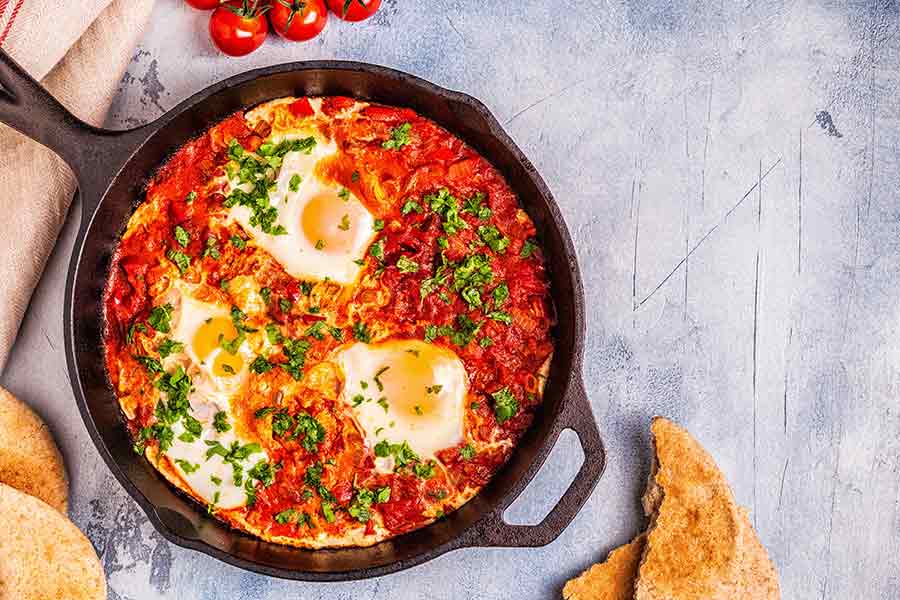
Technically, shakshuka isn’t Middle Eastern; it has its origins in the Maghreb region of North Africa, and Libya, Morocco, Tunisia, and Algeria all claim to have been the birthplace of this popular recipe.
But today, shakshuka is one of the most widely eaten breakfast dishes in the Middle East, particularly in Turkey, Egypt, and Israel. Though it’s traditionally eaten in the morning, it can be enjoyed anytime.
The word ‘shakshuka’ means ‘a mix’, and that’s just what this dish is. Garlic, tomatoes, onions, peppers, and spices like cumin, paprika and pepper are gently simmered til infused with flavour. Then eggs are gently cracked into the mix and cooked until set. Top with fresh parsley and mop up the tasty juices with crusty bread. If you don’t eat eggs, you can always replace them with tofu!
To make shakshuka, try this recipe from Downshiftology or watch the video below.
9. Grilled kofta
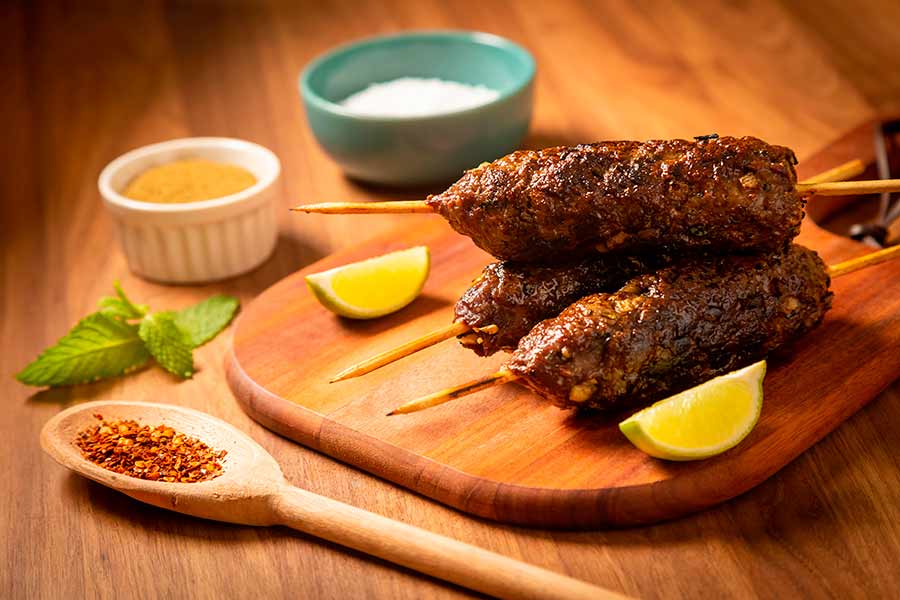
Kofta kebabs are another Middle Eastern dish that’s become popular in the UK.
The word ‘kofta’ comes from ‘kefta’, which is the Persian word for ground or pounded – and because it refers to the method rather than the ingredient, this means you can have meat koftas, seafood koftas, or even veggie koftas. However, the most common type of koftas are made with minced lamb, beef, or chicken.
Whatever you decide to make your kofta from, the secret is to blend it with onions, parsley, garlic, and spices like sumac, nutmeg, cumin, and cardamom. Then, shape your mix into balls or patties, skewer them, and grill until deliciously charred. You can eat koftas with salad or in a pitta or wrap – and for maximum authenticity, serve with hummus or tzatziki too.
To make authentic beef and lamb koftas, try this recipe from Amira’s Pantry or check out the video below. Alternatively, to make a veggie version, this recipe from Rabbit & Wolves is delicious.
10. Tahdig

There’s rice… and then there’s Persian crunchy rice. Officially called ‘tahdig’ (which means ‘bottom of the pot’ in farsi, this is a dish that’s eaten all over Iran, and once you’ve tried it, you may find it difficult to go back to eating plain rice! Though on the surface this rice dish is simple, it’s all about technique – and if you get it right, you’re in for a serious treat.
Tahdig is basically rice that’s laced with saffron and cooked in a tightly covered pan until the bottom layer becomes satisfyingly crunchy and the top layers are fluffy and soft. Once cooked, you tip the pan upside down and the rice comes out like a cake, with the crisp, golden bottom layer acting like a mould for the rest of the rice. You can eat it with salads, koftas, or stews – or enjoy it by itself!
To make authentic Persian crunchy rice, try this recipe by The Mediterranean Plate or check out the video below.
11. Chickpea stew

As we’ve seen, the humble chickpea reigns proudly over Middle Eastern cuisine, and there are many delicious recipes featuring this nutritious legume. However, one of the best – and most adaptable – is chickpea stew.
The most famous variation of this dish is Moroccan chickpea stew, but as we already have a recipe for this on our website, we thought we’d feature a different version: sabanekh bil hummus.
More commonly known as Palestinian chickpea and spinach stew, sabanekh bil hummus is a hearty, healthy veggie stew that’s packed with flavour. Viewed as a comfort food among many Palestinian families, it’s cheap, filling, and absolutely delicious. Garlic, allspice, cumin, and coriander add a punchy, aromatic kick – and the leftovers taste even better. Serve with crusty bread to mop it all up.
To make Palestinian chickpea and spinach stew, try this recipe from Saveur. Or, for a more Moroccan take on this recipe, check out the video below.
12. Knafeh

Another dish of Palestinian origin that’s eaten all over the Middle East is knafeh – and this is another recipe that’s perfect if you have a sweet tooth.
Knafeh is probably unlike any other dessert you’ve ever eaten: made with syrup-soaked vermicelli-like pastry, stuffed with creamy, salty cheese and topped with chopped pistachios and orange blossom, it may sound unorthodox, but it’s heavenly!
It also looks much harder to make than it is, so if you’re looking to impress guests, it’s a good choice. Traditionally knafeh uses Palestinean nabulsi cheese, but this is tricky to find in the UK, so you can use ricotta and/or mozzarella instead. The key ingredient is the kataifi pastry, which you can buy in most Greek, Arab, or Turkish shops. Once the cake is assembled, bake, then soak through with syrup!
To make knafeh, try this recipe from Alpha Foodie or check out the video below.
Final thoughts…
Whether you’re into sweet treats, savoury dips, hearty stews, fresh salads, or meaty kebabs, Middle Eastern food has something for every palate. Thanks to its versatility, it’s a cuisine that can be enjoyed all throughout the year: on a warm day, the aromatic salads are perfect to snack on, and when it’s cold, the richer, more warming dishes are the perfect comfort food.
Thanks to their use of fresh herbs, spices, and health-busting foods like chickpeas, Middle Eastern food is also nutritious, restorative, and good for the immune system – so it’s a great idea to try out some of these recipes as we enter the colder months.
And although the flavours of these recipes are intense and complex, you’ll be pleased to know that making them tends to be easier than you think!
Selene Nelson is an author, freelance journalist, and lifestyle writer for Rest Less. After graduating from the University of Sussex with a degree in English Literature, Selene began contributing to many major newspapers and websites, and has written for the BBC, The Sunday Times, The Independent, Town & Country, and HuffPost. Her specialist subjects include food, travel, and health, though she enjoys writing about a wide range of topics (e.g. her two books are about veganism and psychopathy, respectively!). She enjoys cooking (particularly pasta and Asian noodle soups), reading, travelling, hiking, attempting to keep fit, and watching animal videos on YouTube.
* Links with an * by them are affiliate links which help Rest Less stay free to use as they can result in a payment or benefit to us. You can read more on how we make money here.
